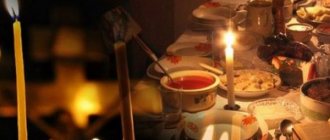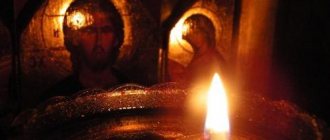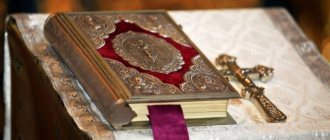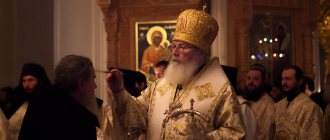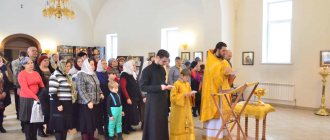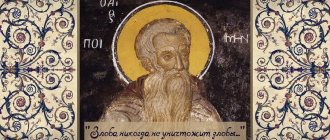MARK OF ATHENS
St. Mark of Athens. Painting of the church of the monastery of the Great Martyr. Panteleimon in Skopje, Macedonia. 1164
St. Mark of Athens. Painting of the church of the monastery of the Great Martyr. Panteleimon in Skopje, Macedonia. 1164
[Greek Μάρκος ὁ ᾿Αθηναῖος] († c. 400), St. (memorial April 5; Greek memory March 5). The story of Abba Serapion's visit to the great ascetic M.A. has the form of a patericon story, but is an independent work that was not included in the ancient patericon collections. D. Papebroek believed that this work arose as a result of the reworking of the Life of Paul of Thebes (ActaSS. 1738. Mai. T. 3. P. 358). This opinion was shared by many. researchers, including L. S. de Tijmon and P. Peeters. The Life of M. A. was preserved in 25 manuscripts of the 12th-19th centuries. H. Angelidi divides the lists of the Life of M. A. into 3 groups and notes that groups of manuscripts B and G were revised (᾿Αγγελίδη. 1989. Σ. 43). During the heyday of Egypt. In monasticism, 8 ascetics are known who bore the name Serapion, including the disciple of St. Anthony the Great and the author of the Life of St. Macarius of Egypt. The Life of M.A. also mentions the “great elder” John, whose identity is also impossible to establish. An ascetic named John lived in Skete and became the successor of St. Macarius of Egypt as a presbyter (Palladius. Lausiac. 17). A much more famous contemporary of M.A., who bore this name, was St. John of Lycopolis, who lived in Thebaid, but the “great old man” John labored in the vicinity of Skete.
The story of Elder Serapion’s journey to M.A. is also preserved in Syriac, Armenian, and Copt. and Arab. versions (BHO, N 605-607). The Life of M.A. was translated into glory. language no later than the 1st third of the 14th century, most likely on Athos, and, obviously, not as part of the menaine collection, which explains the great discrepancy in its calendar date. In Rus', the Life of M. A. became widespread in the end. XIV century, with “second South Slavic influence”, the older list is contained in the parchment collection of the con. XIV century (?) RNB. Weather No. 66, Novgorod in origin and belonging to the 16th century. Sylvester, priest of the Kremlin Annunciation Cathedral.
During a trip to the Skete desert to the “great old man” John, Serapion received a revelation to go for a blessing to the Thracian Mountain in Ethiopia to the 130-year-old hermit M.A., who had no equal among the hermits and fasters and was soon to depart to the Lord. At that time, Ethiopia was the name given to the territory stretching from the Red Sea to Mauritania. Researchers suggest that the Thracian Mountain (Θράκη), called in the east. versions of Tarmak, was located on the territory of modern. Libya.
In Alexandria, Elder Serapion learned from a merchant how to reach the Thracian Mountain. Abba Serapion undertook a journey through the desert, which he was able to accomplish only with the help of angels who appeared to him in the forms of two hermits. The Thracian mountain was located by the sea, had no vegetation and was so high that the elder Serapion climbed it within 7 days. On the last night, he saw an angel of God descending from heaven to M.A., heralding his arrival: “Blessed are you, Abba Mark, and good will come to you! So we brought to you Father Serapion, whom your soul wanted to see, since you did not want to see any other person except him! (᾿Αγγελίδη. 1989. Σ. 48). When Abba Serapion approached the entrance to the cave where M.A. lived, he heard the singing of psalms. M.A. rejoiced at his arrival and exclaimed: “Oh, how great is the feat of my spiritual son Serapion, who undertook the labor to see my abode!” (Ibid. Σ. 49). M.A. told Elder Serapion about his life. He is born. in Athens, studied philosophy, but after the death of his parents he decided to renounce the world. M. A. set sail across the sea on a board, and the waves brought him to the foot of the Fracheskaya Mountain. Here he labored for 95 years, during which time he did not see a single human face. Naked and barefoot, M.A. endured hunger, thirst, cold and attacks from the devil. He ate the dust of the earth and drank sea water. When 30 years had passed, the grace of God and His mercy were poured out on the ascetic. Thick hair grew on M.A.’s body, like that of an animal, hunger and thirst no longer possessed him, angels began to bring food to the saint, and demons did not dare to approach him. M.A. was awarded the gift of miracles: Abba Serapion witnessed how, at his word, the Thracian Mountain moved and returned to its place. During his lifetime, M.A. was awarded a vision of heaven. The ascetic asked Abba Serapion whether idolatry and persecution of Christians continued in the world, and rejoiced when he learned that the persecution had stopped and paganism had been put to shame.
Abba Serapion spent the last night of M.A.'s earthly life with him in wakefulness and singing psalms. He witnessed the blessed death of the saint. M.A. ordered his body to be placed in a cave, and the entrance to it to be blocked with a stone. Returning to Egypt, Abba Serapion told about M.A. to the “great old man” John and the brethren.
To Byzantium. period The Life of M.A. was included mainly in non-calendar collections and is not found in the Synaxarion. Brief synaxarical Lives of St. Mark of the Monk (March 5) is a compilation of biographical information about 3 other ascetics: St. Mark the Hermit, Mark of Nitria, etc. Macarius of Alexandria (SynCP. Col. 509-511).
In South Slavic manuscripts, the Life of M. A. is found under March 5 (the oldest list is BPB. No. 219, 1381) and under April 5. (earlier lists - Ath. Chil. slav. 473, 2nd part 1335-1345, Montenegro. Cetinje Monastery. No. 67, XV century) (Ivanova. Biblioth. hagiogr. P. 478-480, 514-515). In a number of ancient Russian lists, this work has no date in the title (for example, RSL. Vol. No. 657, 1487; RSL. Trinity. No. 745, XIV century, Trinity. No. 752, XV century) and may be considered (in in accordance with the initial words: “Abba Serapion told us...”) like a patericon story. In the VMC Life of M.A. is given under December 31. (VMC. Dec. Days 25-31. Stb. 2484-2496) and under May 1 (Ibid. May. Days. 1-8. P. 149-155). In the Menaion-Chetih of John Milyutin (1646-1654) this Life is given under January 19. and on March 5th. In 1668, the Bollandists placed information about M. A. in the Acta Sanctorum under March 29. St. Demetrius of Rostov placed in his Menaion-Chetya the Life of M.A. under April 5, indicating the source of the text: “from the great Menaion of Chetya” (Dmitry of Rostov, St. Book of Lives of the Saints. K., 1764. Book 3. L. 113 -116 rpm). Celebration date: April 5 established itself in modern times. calendar of the Russian Orthodox Church, whereas in Greek. Church feast day of the saint is March 5th.
In the Martyrology of Rabban Sliba (XIV century), the memory of M. A. is indicated under May 20, and in the Synaxar of Alexandria - under April 16.
Source: BHG, N 1039-1041n; ActaSS. 1668. March. T. 3. P. 40-43; 18633. R. 33-35; Look AE The History of Abba Marcus of Mount Tharmaka. Oxf., 1929 [Sir. version]; ᾿Αγγελίδη Χ. Γ. ῾Ο Βίος τοῦ Μάρκου τοῦ ᾿Αθηναίου (BHG 1039-1041) // Σύμμεικτα. 1989. T. 8. Σ. 45-49 [text]; JSV. Apr. pp. 87-98.
Lit.: ActaSS. 1668. March. T. 3. P. 778-781; Sergius (Spassky). Monthsword. T. 2. S. 19, 98-99, 128, 150, 153, 398; T. 3. P. 132; Sauget J.-M. Marco di Atene, eremita sul monte Tarmaqa, santo // BiblSS. Vol. 8. Col. 701-703; ᾿Αγγελίδη Χ. Γ. ῾Ο Βίος τοῦ Μάρκου τοῦ ᾿Αθηναίου (BHG 1039-1041) // Σύμμεικτα. 1989. T. 8. Σ. 33-44 [research]; Μακάριος Σιμωνοπετρίτης, ἱερομόν. Νέος Συναξαριστὴς τῆς ᾿Ορθοδόξου ᾿Εκκλησίας. ᾿Αθῆναι, 2006. Τ. 7: Μάρτιος. Σ. 60-62; The Ashgate Research Companion to Byzantine Hagiography / Ed. S. Efthymiadis. Farnham, 2011. Vol. 1. P. 45, 80.
O. V. L., A. A. Turilov
Biography[ | ]
According to his life, Saint Mark studied philosophy. When his parents died, he retired to Egypt and settled in a cave on the Thracian Mountain, located in Ethiopia. The devil did not leave him without temptations. Unclean spirits watched and pursued Saint Mark, swore that they would drown him in the sea and, seizing him, dragged him from the mountain with a strong cry: “Get away from our land!” They constantly said: “Since the beginning of the world, no one has come here - how did you dare to come?”
The sources indicate that Mark saw the likeness of a Divine paradise and in it the prophets of God Elijah and Enoch. He told his vision to the monk Serapion. Mark asked Abba Serapion whether the world stood in the law of Christ, whether the persecution of Christians continued. He also asked: “Are there any saints in the world today who work miracles, as the Lord said in His Gospel”: “If you have faith like the grain of a mountain, you say to this mountain: move away from here, and it will pass away, and nothing will be possible for you? » (Matthew 17:20) Immediately after these words, the mountain moved 5,000 cubits (about 2.5 kilometers) and moved closer to the sea. Seeing this, Mark turned to her: “I didn’t order you to move, go back to your place!” After this, the mountain really returned to its place. Abba Serapion fell on his face in fear. The Monk Mark took him by the hand and asked: “Have you not seen such miracles in your life?” “No, father,” answered Elder Serapion. Then the Monk Mark wept bitterly and said: “Woe to the earth, because Christians live on it only in name, and not in deed.” Mark invited him to dinner. Angels of God brought food for the meal. Abba Serapion replied that he had never eaten such delicious food and sweet water. “Brother Serapion,” answered the Monk Mark, “have you seen how many good deeds God sends to His servants! All the days God sent me one loaf and one fish, but now for your sake He doubled the meal - he sent us two loaves and two fish. The Lord God feeds me with such and such a meal throughout the entire period of my first sufferings.”
Hermitage[ | ]
Sources indicate that Saint Mark remained in seclusion for ninety-five years, without seeing a human face, birds or animals. During the first thirty years this was the most difficult time for him. Becoming barefoot and naked, he suffered from heat and cold. He ate rare desert plants, sometimes ate dust and drank bitter sea water. After thirty years, Divine grace descended on him. According to his life, it is indicated that the holy Angels of God brought him food. Over time, long hair grew on his body, which protected him from heat and cold. He stopped his earthly life in the one hundred and thirtieth year of his life.
Death[ | ]
Before his death, Saint Mark offered up prayers for the salvation of the earth, Christians and all those living in peace and the Love of Christ. He commanded Serapion to bury his body in a cave and block the entrance to it. Abba Serapion witnessed how the soul of a hundred and thirty-year-old elder, St. Mark, was accepted into Heaven around the year 400.
Two Angels in the form of hermits escorted Abba Serapion back to the inner desert, where in one of the monasteries Abba Serapion was able to tell about the life and death of St. Mark. Subsequently, he became a disciple of the great elder John.
Biography
According to his life, Saint Mark studied philosophy. When his parents died, he retired to Egypt and settled in a cave on the Thracian Mountain, located in Ethiopia. The devil did not leave him without temptations. Unclean spirits watched and pursued Saint Mark, swore that they would drown him in the sea and, seizing him, dragged him from the mountain with a strong cry: “Get away from our land!” They constantly said: “Since the beginning of the world, no one has come here - how did you dare to come?”
The sources indicate that Mark saw the likeness of a Divine paradise and in it the prophets of God Elijah and Enoch. He told his vision to the monk Serapion. Mark asked Abba Serapion whether the world stood in the law of Christ, whether the persecution of Christians continued. He also asked: “Are there any saints in the world today who work miracles, as the Lord said in His Gospel”: “If you have faith like the grain of a mountain, you say to this mountain: move away from here, and it will pass away, and nothing will be possible for you? » (Matthew 17:20) Immediately after these words, the mountain moved 5,000 cubits (about 2.5 kilometers) and moved closer to the sea. Seeing this, Mark turned to her: “I didn’t order you to move, go back to your place!” After this, the mountain really returned to its place. Abba Serapion fell on his face in fear. The Monk Mark took him by the hand and asked: “Have you not seen such miracles in your life?” “No, father,” answered Elder Serapion. Then the Monk Mark wept bitterly and said: “Woe to the earth, because Christians live on it only in name, and not in deed.” Mark invited him to dinner. Angels of God brought food for the meal. Abba Serapion replied that he had never eaten such delicious food and sweet water. “Brother Serapion,” answered the Monk Mark, “have you seen how many good deeds God sends to His servants! All the days God sent me one loaf and one fish, but now for your sake He doubled the meal - he sent us two loaves and two fish. The Lord God feeds me with such and such a meal throughout the entire period of my first sufferings.”
Hermitage
Sources indicate that Saint Mark remained in seclusion for ninety-five years, without seeing a human face, birds or animals. During the first thirty years this was the most difficult time for him. Becoming barefoot and naked, he suffered from heat and cold. He ate rare desert plants, sometimes ate dust and drank bitter sea water. After thirty years, Divine grace descended on him. According to his life, it is indicated that the holy Angels of God brought him food. Over time, long hair grew on his body, which protected him from heat and cold. He stopped his earthly life in the one hundred and thirtieth year of his life.
Death
Before his death, Saint Mark offered up prayers for the salvation of the earth, Christians and all those living in peace and the Love of Christ. He commanded Serapion to bury his body in a cave and block the entrance to it. Abba Serapion witnessed how the soul of a hundred and thirty-year-old elder, St. Mark, was accepted into Heaven around the year 400.
Two Angels in the form of hermits escorted Abba Serapion back to the inner desert, where in one of the monasteries Abba Serapion was able to tell about the life and death of St. Mark. Subsequently, he became a disciple of the great elder John.
